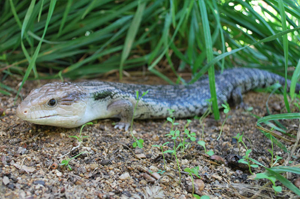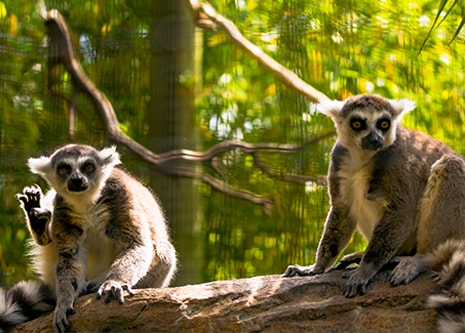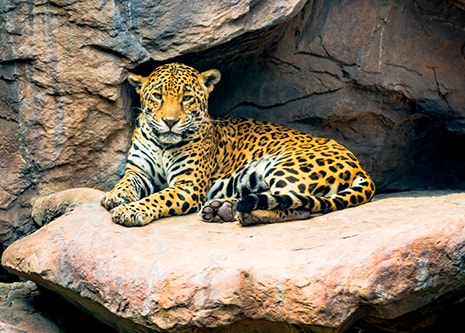
- VisitSupport Happy HollowDONATE TODAYExploreSupport Happy HollowDONATE TODAYLearnSupport Happy HollowDONATE TODAYSupport
-
Today's Hours: 10:00 am to 4:00 pm
Education AmbassadorsIndonesian blue-tongued skink

Scientific name: Tiliqua gigas gigas
Family: Scincidae
Order: Squamata
Class: Reptilia
Range: Eastern Indonesian Islands
Habitat: Grassland, Woodland
Lifespan: 18 to 20 years in captivityWhat do they look like?
Blue-tongued skinks are fairly large lizards, reaching 18 to 20 inches in length. They have long, solid bodies, triangular-shaped heads and comparatively small legs. The tail is slightly shorter than the length of the body and tapers to a point. There are several species of blue-tongued skinks inhabiting Australia and Indonesia, which all differ slightly in appearance. Indonesian blue-tongued skinks vary in color among individuals but are generally grey or pale brown with irregular dark brown or black bands across the back and tail. Their legs are mostly black with small specks of white. They are also equipped with a blue tongue.How do they behave?
Indonesian blue-tongued skinks live in arid grasslands and dry sclerophyll forests. Their short legs do not allow them to climb easily, so they spend the vast majority of their time on the ground hiding in the brush or in shallow burrows carved by their shovel-like snouts. They are diurnal (active during the daytime) and they generally find cover to rest under at night. Even though skinks have very sturdy, solid tails, they can release them like some other lizard species. This is used as a defense mechanism when necessary. Their tails will heal over, sometimes growing back, but never reform exactly like the original. Blue-tongued skinks may also display their blue tongue when threatened.What do they eat?
Blue-tongued skinks are omnivorous, eating both animal and plant matter. In the wild, they eat fruit, insects, mollusks and carrion. At Happy Hollow, they are fed fruits, vegetables and insects.How are they born?
Unlike most reptile species, these skinks do not lay eggs. Instead they are ovoviviparous, meaning they give birth to live young encased in membranous sacs. Mating occurs in the spring months. Gestation lasts three to four months and results in five to 15 young. Neonates are able to feed on their own after birth and are reared quickly.Conservation
The conservation status of Indonesian blue-tongued skinks has not been evaluated by the International Union for Conservation of Nature . However excessively catching wild skinks for the pet trade could lead to a threatened status. Wild-caught animals will often refuse to eat in captivity and can carry parasites. Poor conditions of importation often lead to stressed and aggressive animals. If you would like to help Indonesian blue-tongued skinks, do not support the illegal pet trade by purchasing wild-caught skinks. Make sure potential pets are captive-bred in the United States rather than being imported from Indonesia. If you are considering a skink as a pet, make sure to do your research and consider adopting from your local animal shelter or reptile rescue group. For more information on reptile rescue in the bay area check out the Bay Area Amphibian and Reptile Society at www.baars.org.
Zoo on the Hill
Located across from the Keep-Around Carousel is the Zoo on the Hill. Learn about wildlife up close during daily meet-and-greets, leap like a lemur on the playground, brush and feed the goats,, or take a peek inside Doc’s Critter Care building and the Ranch House. Double-H Ranch features a combination of animal exhibits, including giant anteaters and red ruffed lemurs, as well chickens and domesticated animals that are docile enough to touch.

Zoo in the Hollow
Follow the crooked bamboo pathway down into the hollow and visit with some of the most amazing animals in the world. Where else in San José can you get up close to a stunning jaguar, lemur, meerkat or American alligator? Happy Hollow is dedicated to helping save species and preserve wildlife for future generations by participating in Species Survival Plan programs through the Association of Zoos and Aquariums.